Define Our Future
15 February 2024
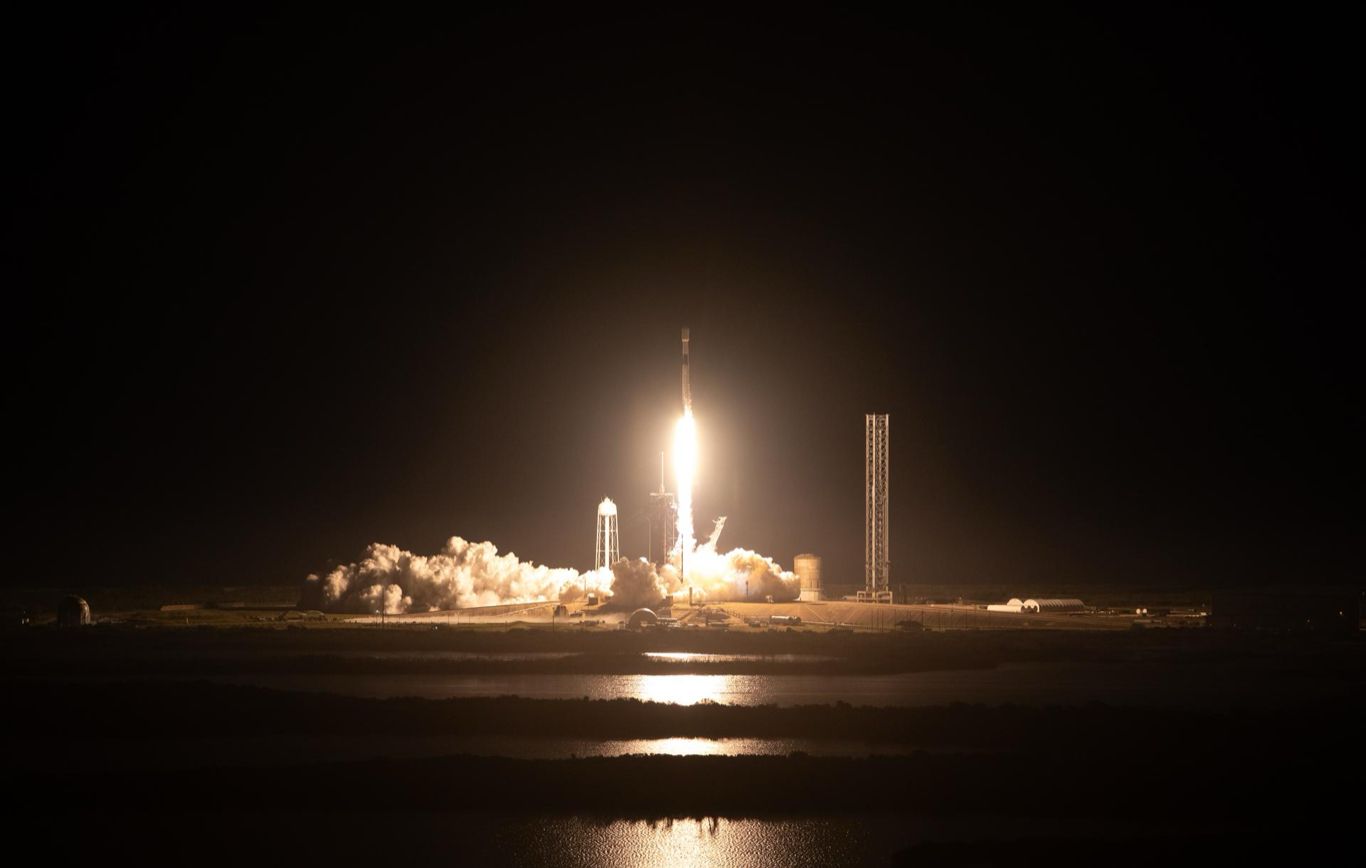
Intuitive Machines launch in Falcon-9 (Image - NASA/Kim Shiflett)
On Thursday 15th February, Intuitive Machines (US) launched its first lunar mission, with their Nova-C lander. Theirs will be the latest attempt at becoming the first commercial company to successfully perform a soft landing on the Moon, after a failed attempt from Astrobotic (US) in January, and a hard landing from iSpace (Japan) in April last year.
The lander was launched atop a SpaceX Falcon-9 and commenced a short journey to the Moon. They aim to land close to the lunar south pole on February 22nd, where numerous payloads will be activated, including payloads under NASA’s Commercial Lunar Payload Services (CLPS) program.
These include the Laser Retroreflector Array (LRA), which will function as a permanent location reflector beacon to help future missions determine their distance from the surface, and the Stereo Cameras for Lunar Plume-Surface Studies (SCALPSS), which are used to observe the lunar dust plumes as the spacecraft lands. Fine lunar dust is incredibly dangerous for vehicles and human exposure, which is a (one) reason why exclusion zones are activated around a lander.
Other payloads include an NFT art collection by Jeff Koons, and Lonestar Data Holding’s first ever data centre for the lunar surface, a demonstration of off-world secure data storage.
Landings such as this are fraught with risks, as seen with other missions, but Intuitive Machines could be on course to make history. They are also part of a busy launch cadence for this year alone, with two more IM missions planned, another attempt from iSpace and Astrobotic, and a first attempt from Firefly Aerospace with their Blue Ghost lander.
UK fund outer space projects
The UK has boosted their role in lunar exploration this week with the UK Space Agency adding funding support for global outer space exploration projects, under the Space Science and Exploration Bilateral Programme.
The fund will assist university Royal Hollaway in developing software for India’s Chandrayaan-2 lunar orbiter to detect ice at the lunar south pole, a crucial step towards establishing a sustained lunar infrastructure. Similarly, the University of Leicester will gain from help towards the development of their Raman spectroscopy instrument, which will be used on the iSpace rover and lander missions, detecting water ice on the Moon.
The UK is a growing space nation, with the space sector being marked as a post-Brexit priority by the UK government, and has quadrupled in size to almost £17 million since 2000.
NASA fission energy for the Moon, and SpaceX plan for Mars colony
NASA are also progressing with other plans to develop the lunar infrastructure, through their Fission Surface Power Project to develop a nuclear fission reactor for use on the Moon and Mars. The agency is completing the first phase of the project, which aims to develop small fission reactors to develop energy. They awarded contracts to commercial companies for initial designs of a reactor that can provide power for up to 10 years.
The use of fission could provide an uninterrupted energy supply, even during the long 14-day lunar nights, and designs have also been presented by Rolls-Royce. Phase 2 of NASA’s project is due to begin in 2025, when partners will be tasked with designing the final reactor, with plans to send it to the Moon early next decade.
SpaceX are seemingly mapping-out an even broader vision of an interplanetary infrastructure, with Elon Musk this week detailing plans about how to sustain a civilisation on the Mars. On an X.com post he wrote “We are mapping out a game plan to get a million people to Mars. Civilization only passes the single-planet Great Filter* when Mars can survive even if Earth supply ships stop coming.”
He previously stated that Starship could make it Mars within 5 years, with a first target date of 2033. Furthermore, back in 2020, Musk laid out more specific applications for Starship and a Martian civilisation, stating that "Building 100 Starships/year gets to 1000 in 10 years or 100 megatons/year or maybe around 100k people per Earth-Mars orbital sync," (X.com).
Musk is known for his highly optimistic outlook and outspoken X posts. However, Starship is moving forwards in development, and successfully reached space in its last demo launch. Their third attempt will reportedly be in weeks, with a new fully-stacked Starship already on the pad.
*concept developed by Robin Hanson that there are great barriers in the development of intelligent life from its earliest form, which makes detectable extraterrestrial life exceedingly rare
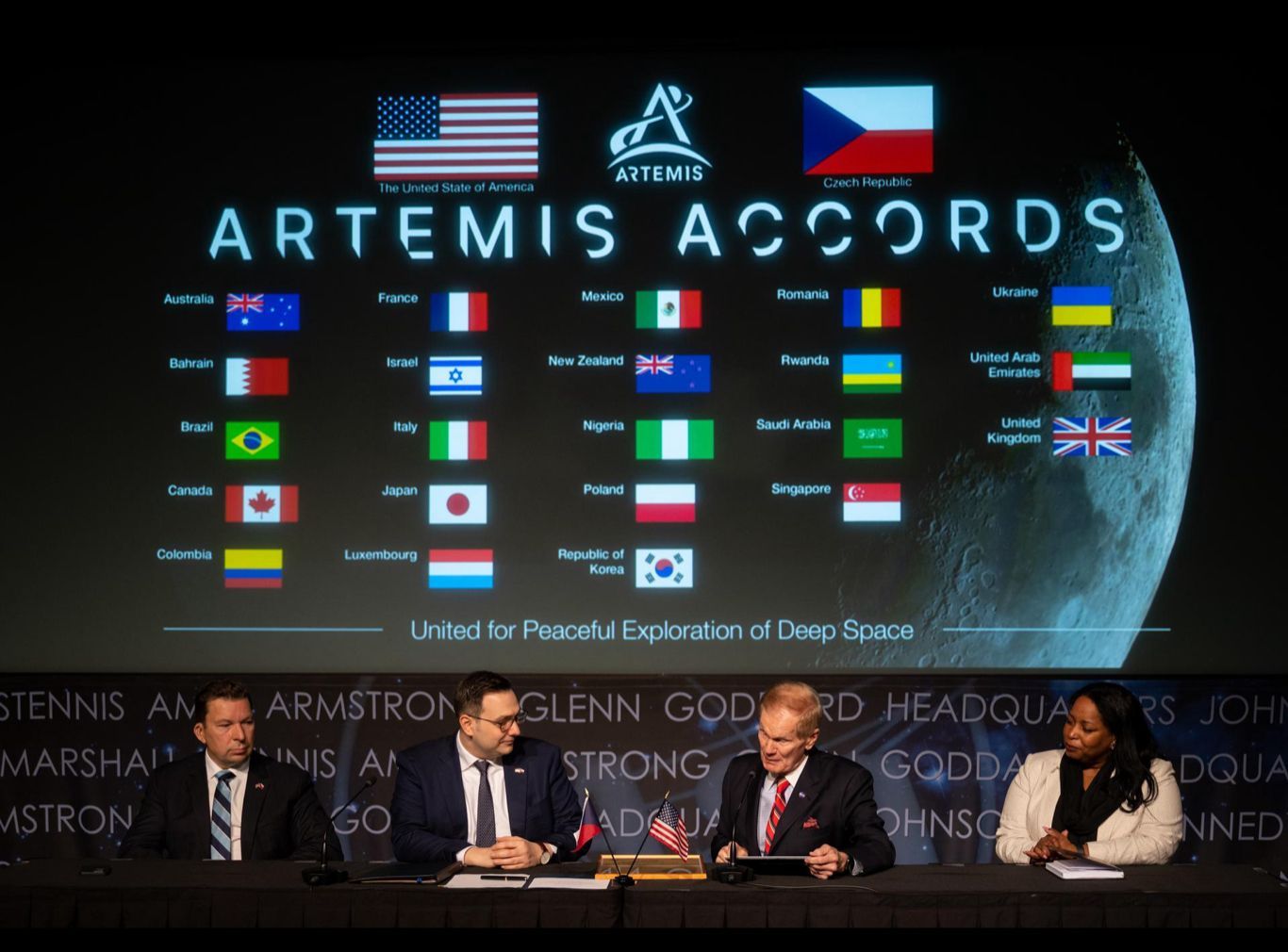
Czech Republic sign Accords last year (Image - NASA/Joel Kowsky)
Greece commit to Artemis Accords, US realign commercial ties, Europe further commits to industry growth
The US again expanded their Artemis Accords network this week, with Greece becoming the 35th nation to sign-on. The Accords are a non-binding set of rules, norms and regulations governing activities in outer space and the Moon, and cover critical areas such as resource extraction.
They are now pulling way ahead of China, who lead a similar goal under their International Lunar Research Station (ILRS) project, which to date have gained signatures from 14 members (which includes nations, institutes and companies).
The necessity for a comprehensive roadmap governing and regulating outer space is becoming more evident, especially while we enter a new commercial lunar age, with the prospect of utilising and retrieving valuable space-based resources.
A new “space race” narrative is increasingly being used in reference to the competing lunar exploration programmes in play by the US and China, and their respective allies. This week the US Department of the Airforce revealed a new long-term strategy to revamp and reshape the operations of the US Air Force and Space Force in the wake of this growing rivalry, with Air Force Secretary Frank Kendall referring to this as the era of “great power competition”.
This competition refers to the growing geopolitical and economic rivalry between these two superpowers.
The space race narrative has been growing in recent months, with NASA head, Bill Nelson, saying last year that “It is a fact: we’re in a space race…we better watch out that they (China) don’t get to a place on the moon under the guise of scientific research. And it is not beyond the realm of possibility that they say, ‘Keep out, we’re here, this is our territory.’”
He went on to refer to examples of such behaviour on Earth, such as in the South China Sea, where China have established military bases on contested territory, saying “…look at what they did with the Spratly Islands.” Space is fast becoming a new frontier of geopolitical debate.
Europe boost space industry, continuing path to refocus commercial plans
A new space race largely refers to the US and China, but mention must able be made of other nations and entities. Last year we read much about ESA and their plans to refocus their space strategy, based upon commercialisation and exemplifying the roaring success of private space companies in the US.
At a summit in November, the agency announced that they will now be looking to purchase launch services from the private sector (as appose to developing their own), in the same way that NASA does with companies such as SpaceX and Rocket Lab. ESA head, Josef Aschbacher, also declared that ESA will not “miss the train” on space, and insisted that Europe will develop their own Moon base by next decade.
This decisive rhetoric has continued this week, with the European Commission (EC), European Investment Bank (EIB) and ESA announcing that they are joining forces to further boost the European commercial space sector. The idea is “to foster cooperation and coordination with a focus on providing financing and advisory support for European space companies”.
Despite setbacks and a lack of independant access to space, it seems Europe is changing pace and direction. With native maiden launches planned from European soil this year, we could be witnessing a turning point and the emergence of growing space power.
OPINION: While competition expands, we may need new mediators for peace
Not only does space exploration still lack the necessary framework to govern it and ensure peace, but it is becoming increasingly competitive and contentious, namely in relation to territorial and mineral appropriation. Conflict and dispute over such issues are never inevitable, but comparative history tells us that peace is far from guaranteed.
However, with more entities expanding their place in the space sector, another outlook could be that these newer players, such as ESA, India and the UAE could play a bigger role in mediating affairs. Romania’s suggestion last week at the UN COPUOS, of a “consultative mechanism” for activities on the Moon, gave us an idea of what these nations could do, in the quest to maintain peaceful uses of outer space.
Define Our Future
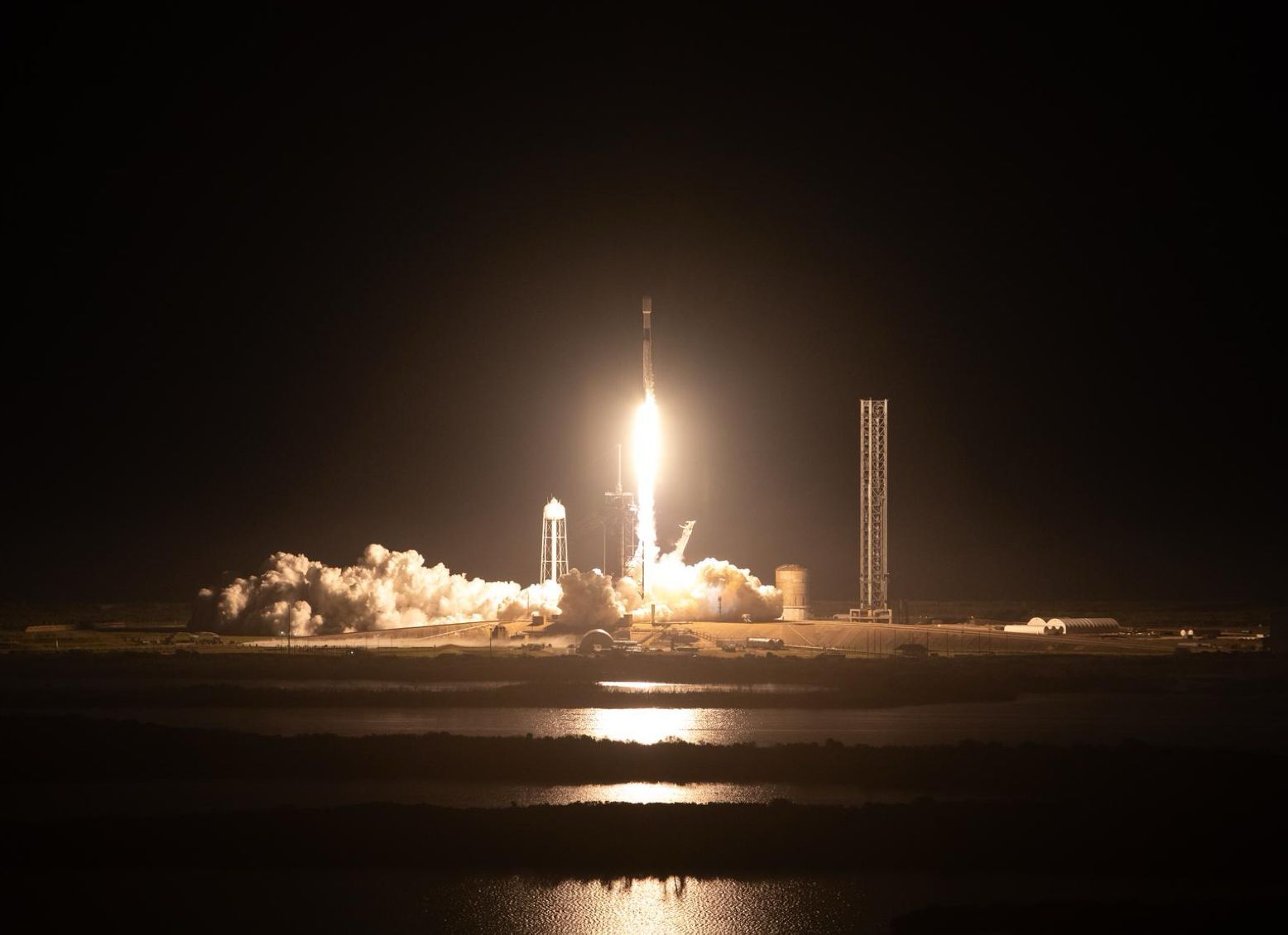
Intuitive Machines launch in Falcon-9 (Image - NASA/Kim Shiflett)
15 February 2024
Intuitive Machines Embarks on Lunar Mission, U.S. Gains Space Ally, Musk Unveils Vision for Mars Colony - Space News Roundup
On Thursday 15th February, Intuitive Machines (US) launched its first lunar mission, with their Nova-C lander. Theirs will be the latest attempt at becoming the first commercial company to successfully perform a soft landing on the Moon, after a failed attempt from Astrobotic (US) in January, and a hard landing from iSpace (Japan) in April last year.
The lander was launched atop a SpaceX Falcon-9 and commenced a short journey to the Moon. They aim to land close to the lunar south pole on February 22nd, where numerous payloads will be activated, including payloads under NASA’s Commercial Lunar Payload Services (CLPS) program.
These include the Laser Retroreflector Array (LRA), which will function as a permanent location reflector beacon to help future missions determine their distance from the surface, and the Stereo Cameras for Lunar Plume-Surface Studies (SCALPSS), which are used to observe the lunar dust plumes as the spacecraft lands. Fine lunar dust is incredibly dangerous for vehicles and human exposure, which is a (one) reason why exclusion zones are activated around a lander.
Other payloads include an NFT art collection by Jeff Koons, and Lonestar Data Holding’s first ever data centre for the lunar surface, a demonstration of off-world secure data storage.
Landings such as this are fraught with risks, as seen with other missions, but Intuitive Machines could be on course to make history. They are also part of a busy launch cadence for this year alone, with two more IM missions planned, another attempt from iSpace and Astrobotic, and a first attempt from Firefly Aerospace with their Blue Ghost lander.
UK fund outer space projects
The UK has boosted their role in lunar exploration this week with the UK Space Agency adding funding support for global outer space exploration projects, under the Space Science and Exploration Bilateral Programme.
The fund will assist university Royal Hollaway in developing software for India’s Chandrayaan-2 lunar orbiter to detect ice at the lunar south pole, a crucial step towards establishing a sustained lunar infrastructure. Similarly, the University of Leicester will gain from help towards the development of their Raman spectroscopy instrument, which will be used on the iSpace rover and lander missions, detecting water ice on the Moon.
The UK is a growing space nation, with the space sector being marked as a post-Brexit priority by the UK government, and has quadrupled in size to almost £17 million since 2000.
NASA fission energy for the Moon, and SpaceX plan for Mars colony
NASA are also progressing with other plans to develop the lunar infrastructure, through their Fission Surface Power Project to develop a nuclear fission reactor for use on the Moon and Mars. The agency is completing the first phase of the project, which aims to develop small fission reactors to develop energy. They awarded contracts to commercial companies for initial designs of a reactor that can provide power for up to 10 years.
The use of fission could provide an uninterrupted energy supply, even during the long 14-day lunar nights, and designs have also been presented by Rolls-Royce. Phase 2 of NASA’s project is due to begin in 2025, when partners will be tasked with designing the final reactor, with plans to send it to the Moon early next decade.
SpaceX are seemingly mapping-out an even broader vision of an interplanetary infrastructure, with Elon Musk this week detailing plans about how to sustain a civilisation on the Mars. On an X.com post he wrote “We are mapping out a game plan to get a million people to Mars. Civilization only passes the single-planet Great Filter* when Mars can survive even if Earth supply ships stop coming.”
He previously stated that Starship could make it Mars within 5 years, with a first target date of 2033. Furthermore, back in 2020, Musk laid out more specific applications for Starship and a Martian civilisation, stating that "Building 100 Starships/year gets to 1000 in 10 years or 100 megatons/year or maybe around 100k people per Earth-Mars orbital sync," (X.com).
Musk is known for his highly optimistic outlook and outspoken X posts. However, Starship is moving forwards in development, and successfully reached space in its last demo launch. Their third attempt will reportedly be in weeks, with a new fully-stacked Starship already on the pad.
*concept developed by Robin Hanson that there are great barriers in the development of intelligent life from its earliest form, which makes detectable extraterrestrial life exceedingly rare
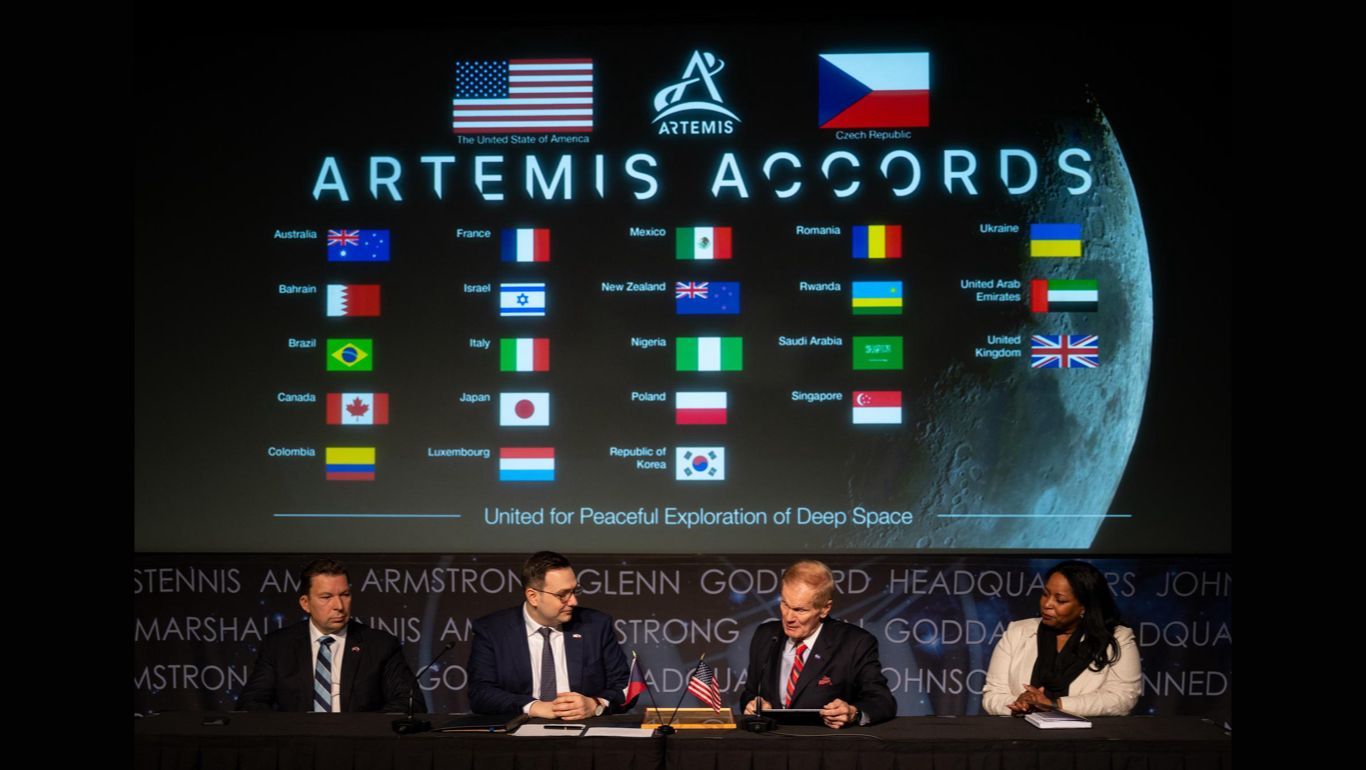
Czech Republic sign Accords last year (Image - NASA/Joel Kowsky)
Greece commit to Artemis Accords, US realign commercial ties, Europe further commits to industry growth
The US again expanded their Artemis Accords network this week, with Greece becoming the 35th nation to sign-on. The Accords are a non-binding set of rules, norms and regulations governing activities in outer space and the Moon, and cover critical areas such as resource extraction.
They are now pulling way ahead of China, who lead a similar goal under their International Lunar Research Station (ILRS) project, which to date have gained signatures from 14 members (which includes nations, institutes and companies).
The necessity for a comprehensive roadmap governing and regulating outer space is becoming more evident, especially while we enter a new commercial lunar age, with the prospect of utilising and retrieving valuable space-based resources.
A new “space race” narrative is increasingly being used in reference to the competing lunar exploration programmes in play by the US and China, and their respective allies. This week the US Department of the Airforce revealed a new long-term strategy to revamp and reshape the operations of the US Air Force and Space Force in the wake of this growing rivalry, with Air Force Secretary Frank Kendall referring to this as the era of “great power competition”.
This competition refers to the growing geopolitical and economic rivalry between these two superpowers.
The space race narrative has been growing in recent months, with NASA head, Bill Nelson, saying last year that “It is a fact: we’re in a space race…we better watch out that they (China) don’t get to a place on the moon under the guise of scientific research. And it is not beyond the realm of possibility that they say, ‘Keep out, we’re here, this is our territory.’”
He went on to refer to examples of such behaviour on Earth, such as in the South China Sea, where China have established military bases on contested territory, saying “…look at what they did with the Spratly Islands.” Space is fast becoming a new frontier of geopolitical debate.
Europe boost space industry, continuing path to refocus commercial plans
A new space race largely refers to the US and China, but mention must able be made of other nations and entities. Last year we read much about ESA and their plans to refocus their space strategy, based upon commercialisation and exemplifying the roaring success of private space companies in the US.
At a summit in November, the agency announced that they will now be looking to purchase launch services from the private sector (as appose to developing their own), in the same way that NASA does with companies such as SpaceX and Rocket Lab. ESA head, Josef Aschbacher, also declared that ESA will not “miss the train” on space, and insisted that Europe will develop their own Moon base by next decade.
This decisive rhetoric has continued this week, with the European Commission (EC), European Investment Bank (EIB) and ESA announcing that they are joining forces to further boost the European commercial space sector. The idea is “to foster cooperation and coordination with a focus on providing financing and advisory support for European space companies”.
Despite setbacks and a lack of independant access to space, it seems Europe is changing pace and direction. With native maiden launches planned from European soil this year, we could be witnessing a turning point and the emergence of growing space power.
OPINION: While competition expands, we may need new mediators for peace
Not only does space exploration still lack the necessary framework to govern it and ensure peace, but it is becoming increasingly competitive and contentious, namely in relation to territorial and mineral appropriation. Conflict and dispute over such issues are never inevitable, but comparative history tells us that peace is far from guaranteed.
However, with more entities expanding their place in the space sector, another outlook could be that these newer players, such as ESA, India and the UAE could play a bigger role in mediating affairs. Romania’s suggestion last week at the UN COPUOS, of a “consultative mechanism” for activities on the Moon, gave us an idea of what these nations could do, in the quest to maintain peaceful uses of outer space.
Share this article
15 February 2024
Intuitive Machines Embarks on Lunar Mission, U.S. Gains Space Ally, Musk Unveils Vision for Mars Colony - Space News Roundup
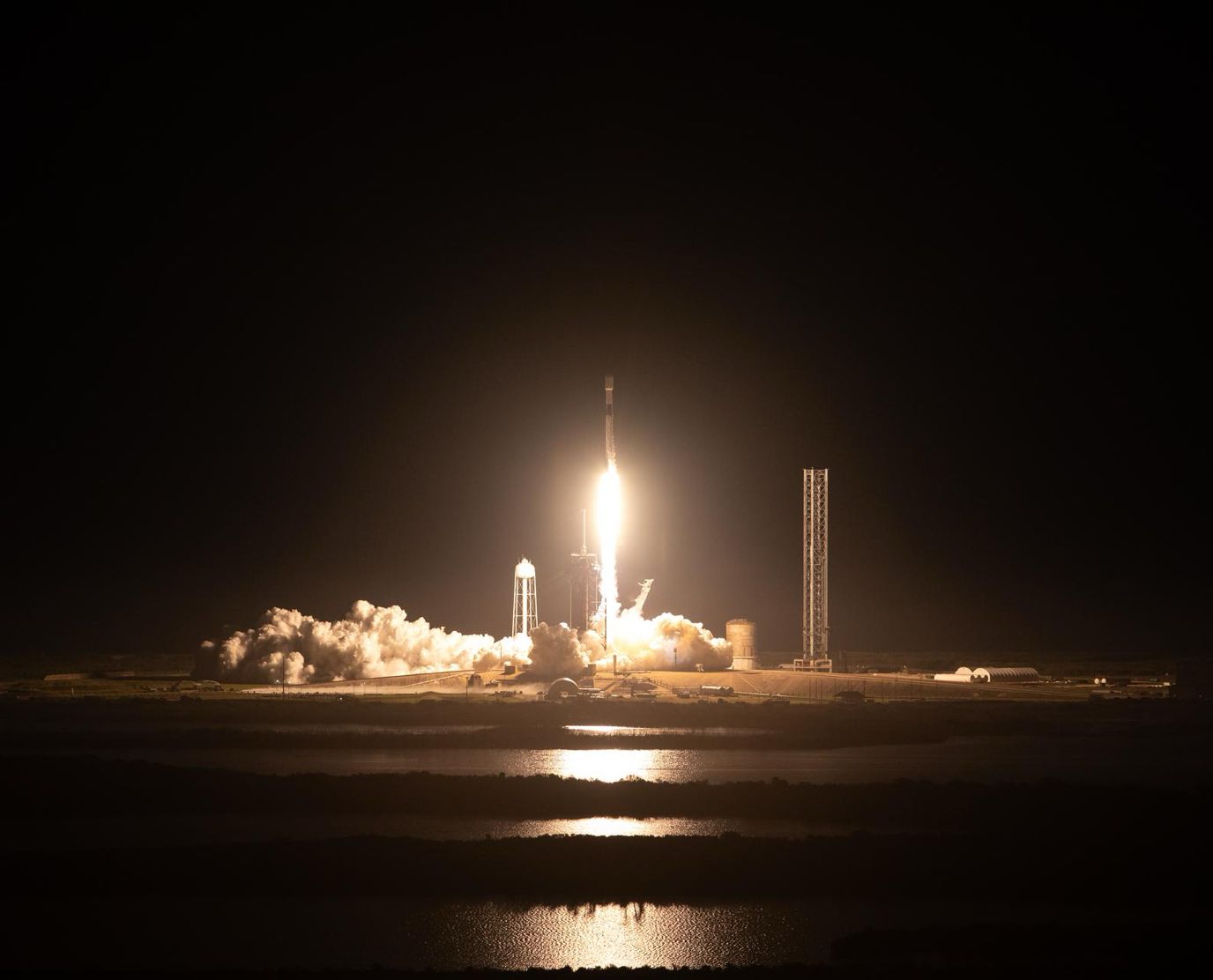
Intuitive Machines launch in Falcon-9 (Image - NASA/Kim Shiflett)
On Thursday 15th February, Intuitive Machines (US) launched its first lunar mission, with their Nova-C lander. Theirs will be the latest attempt at becoming the first commercial company to successfully perform a soft landing on the Moon, after a failed attempt from Astrobotic (US) in January, and a hard landing from iSpace (Japan) in April last year.
The lander was launched atop a SpaceX Falcon-9 and commenced a short journey to the Moon. They aim to land close to the lunar south pole on February 22nd, where numerous payloads will be activated, including payloads under NASA’s Commercial Lunar Payload Services (CLPS) program.
These include the Laser Retroreflector Array (LRA), which will function as a permanent location reflector beacon to help future missions determine their distance from the surface, and the Stereo Cameras for Lunar Plume-Surface Studies (SCALPSS), which are used to observe the lunar dust plumes as the spacecraft lands. Fine lunar dust is incredibly dangerous for vehicles and human exposure, which is a (one) reason why exclusion zones are activated around a lander.
Other payloads include an NFT art collection by Jeff Koons, and Lonestar Data Holding’s first ever data centre for the lunar surface, a demonstration of off-world secure data storage.
Landings such as this are fraught with risks, as seen with other missions, but Intuitive Machines could be on course to make history. They are also part of a busy launch cadence for this year alone, with two more IM missions planned, another attempt from iSpace and Astrobotic, and a first attempt from Firefly Aerospace with their Blue Ghost lander.
UK fund outer space projects
The UK has boosted their role in lunar exploration this week with the UK Space Agency adding funding support for global outer space exploration projects, under the Space Science and Exploration Bilateral Programme.
The fund will assist university Royal Hollaway in developing software for India’s Chandrayaan-2 lunar orbiter to detect ice at the lunar south pole, a crucial step towards establishing a sustained lunar infrastructure. Similarly, the University of Leicester will gain from help towards the development of their Raman spectroscopy instrument, which will be used on the iSpace rover and lander missions, detecting water ice on the Moon.
The UK is a growing space nation, with the space sector being marked as a post-Brexit priority by the UK government, and has quadrupled in size to almost £17 million since 2000.
NASA fission energy for the Moon, and SpaceX plan for Mars colony
NASA are also progressing with other plans to develop the lunar infrastructure, through their Fission Surface Power Project to develop a nuclear fission reactor for use on the Moon and Mars. The agency is completing the first phase of the project, which aims to develop small fission reactors to develop energy. They awarded contracts to commercial companies for initial designs of a reactor that can provide power for up to 10 years.
The use of fission could provide an uninterrupted energy supply, even during the long 14-day lunar nights, and designs have also been presented by Rolls-Royce. Phase 2 of NASA’s project is due to begin in 2025, when partners will be tasked with designing the final reactor, with plans to send it to the Moon early next decade.
SpaceX are seemingly mapping-out an even broader vision of an interplanetary infrastructure, with Elon Musk this week detailing plans about how to sustain a civilisation on the Mars. On an X.com post he wrote “We are mapping out a game plan to get a million people to Mars. Civilization only passes the single-planet Great Filter* when Mars can survive even if Earth supply ships stop coming.”
He previously stated that Starship could make it Mars within 5 years, with a first target date of 2033. Furthermore, back in 2020, Musk laid out more specific applications for Starship and a Martian civilisation, stating that "Building 100 Starships/year gets to 1000 in 10 years or 100 megatons/year or maybe around 100k people per Earth-Mars orbital sync," (X.com).
Musk is known for his highly optimistic outlook and outspoken X posts. However, Starship is moving forwards in development, and successfully reached space in its last demo launch. Their third attempt will reportedly be in weeks, with a new fully-stacked Starship already on the pad.
*concept developed by Robin Hanson that there are great barriers in the development of intelligent life from its earliest form, which makes detectable extraterrestrial life exceedingly rare
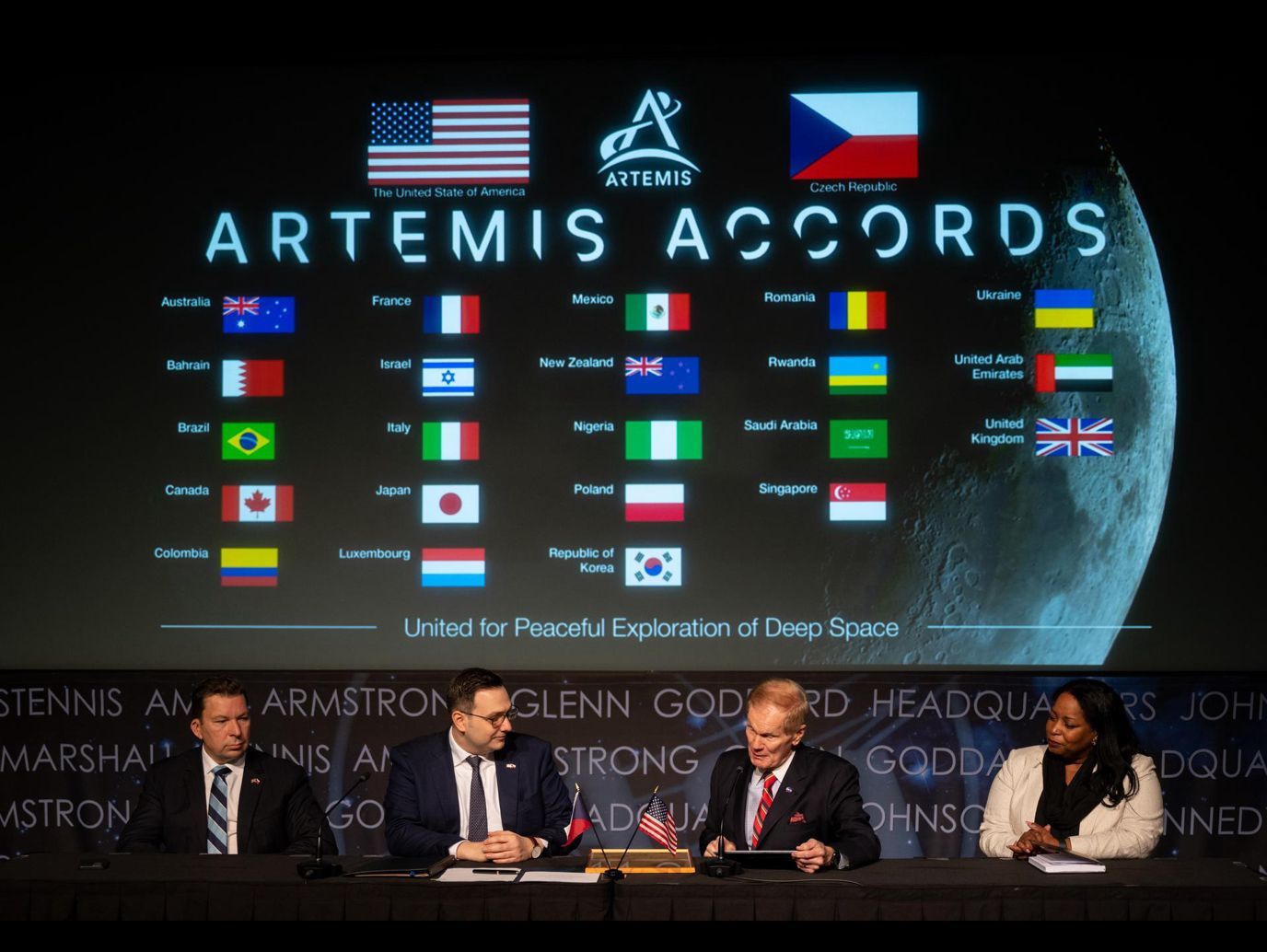
Czech Republic sign Accords last year (Image - NASA/Joel Kowsky)
Greece commit to Artemis Accords, US realign commercial ties, Europe further commits to industry growth
The US again expanded their Artemis Accords network this week, with Greece becoming the 35th nation to sign-on. The Accords are a non-binding set of rules, norms and regulations governing activities in outer space and the Moon, and cover critical areas such as resource extraction.
They are now pulling way ahead of China, who lead a similar goal under their International Lunar Research Station (ILRS) project, which to date have gained signatures from 14 members (which includes nations, institutes and companies).
The necessity for a comprehensive roadmap governing and regulating outer space is becoming more evident, especially while we enter a new commercial lunar age, with the prospect of utilising and retrieving valuable space-based resources.
A new “space race” narrative is increasingly being used in reference to the competing lunar exploration programmes in play by the US and China, and their respective allies. This week the US Department of the Airforce revealed a new long-term strategy to revamp and reshape the operations of the US Air Force and Space Force in the wake of this growing rivalry, with Air Force Secretary Frank Kendall referring to this as the era of “great power competition”.
This competition refers to the growing geopolitical and economic rivalry between these two superpowers.
The space race narrative has been growing in recent months, with NASA head, Bill Nelson, saying last year that “It is a fact: we’re in a space race…we better watch out that they (China) don’t get to a place on the moon under the guise of scientific research. And it is not beyond the realm of possibility that they say, ‘Keep out, we’re here, this is our territory.’”
He went on to refer to examples of such behaviour on Earth, such as in the South China Sea, where China have established military bases on contested territory, saying “…look at what they did with the Spratly Islands.” Space is fast becoming a new frontier of geopolitical debate.
Europe boost space industry, continuing path to refocus commercial plans
A new space race largely refers to the US and China, but mention must able be made of other nations and entities. Last year we read much about ESA and their plans to refocus their space strategy, based upon commercialisation and exemplifying the roaring success of private space companies in the US.
At a summit in November, the agency announced that they will now be looking to purchase launch services from the private sector (as appose to developing their own), in the same way that NASA does with companies such as SpaceX and Rocket Lab. ESA head, Josef Aschbacher, also declared that ESA will not “miss the train” on space, and insisted that Europe will develop their own Moon base by next decade.
This decisive rhetoric has continued this week, with the European Commission (EC), European Investment Bank (EIB) and ESA announcing that they are joining forces to further boost the European commercial space sector. The idea is “to foster cooperation and coordination with a focus on providing financing and advisory support for European space companies”.
Despite setbacks and a lack of independant access to space, it seems Europe is changing pace and direction. With native maiden launches planned from European soil this year, we could be witnessing a turning point and the emergence of growing space power.
OPINION: While competition expands, we may need new mediators for peace
Not only does space exploration still lack the necessary framework to govern it and ensure peace, but it is becoming increasingly competitive and contentious, namely in relation to territorial and mineral appropriation. Conflict and dispute over such issues are never inevitable, but comparative history tells us that peace is far from guaranteed.
However, with more entities expanding their place in the space sector, another outlook could be that these newer players, such as ESA, India and the UAE could play a bigger role in mediating affairs. Romania’s suggestion last week at the UN COPUOS, of a “consultative mechanism” for activities on the Moon, gave us an idea of what these nations could do, in the quest to maintain peaceful uses of outer space.
Share this article
External Links
This Week
News articles posted here are not property of ANASDA GmbH and belong to their respected owners. Postings here are external links only.








